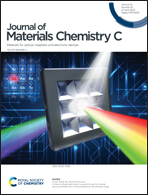Modulating electronic and optical properties of monolayered MoS2 by covalent mono- and bisfunctionalization†
Abstract
By employing first-principles simulations, we present theoretical predictions regarding the modification of structural, electronic and optical properties of 2H- and 1T′-MoS2 monolayers by covalent mono- and bisfunctionalization. Specifically, non-aromatic groups (–F, –NH2, –CH3, –CH2CH2 CN and –CH2CH2 OH) and aromatic (–Ph, –PhNO2 and PhOH) groups are utilized for monofunctionalization, and –F/–NH2, –NH2/–CH3 and –CH3/–Ph for bisfunctionalization. The stability of functionalized 2H- and 1T′-MoS2 monolayers mainly depends on the bonded groups and their surface coverage. In particular, the mixed bisfunctionalization with –F/–CH3 and –NH2/–CH3 groups enhances the stability of 2H-MoS2 through the formation of intermolecular hydrogen bonds. Both 2H- and 1T′-MoS2 can serve not only as electron donors, but also as electron acceptors, subject to the charge transfer behavior of the attached groups. Furthermore, mono- and bisfunctionalization are predicted to be efficient approaches to control the electronic band gaps in 2H- and 1T′-MoS2, where the corresponding values can be tuned by varying the coverage of the absorbed groups. At the same time, the choice of the chemical groups and their coverage also effectively determines the optical adsorption range and intensity. Therefore, our work shows that chemical functionalization of 2D materials with varying coverage can be an important approach to extend the scope of 2D materials in specific electronic and optoelectronic applications.



 Please wait while we load your content...
Please wait while we load your content...